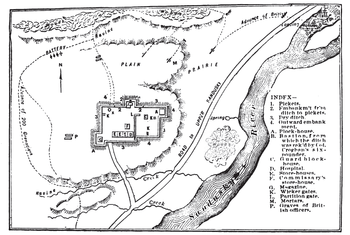Battle of Fort Stephenson
The Battle of Fort Stephenson in August 1813 was an American victory during the War of 1812. American forces successfully defended the fort in August 1813; it guarded an important supply depot. It was located on the west bank of the Sandusky River more than 10 miles upstream from Sandusky Bay in what is now Ohio. The town of Fremont, Ohio developed around the site.
Background
After failing to defeat American forces in the siege of Fort Meigs, the British under Henry Procter withdrew. Procter attempted to take Fort Meigs again in July by staging a mock battle to lure the defenders out of the fort. The ploy failed, and Procter abandoned the idea of taking the fort.
The British and Indian force moved east to try to capture an American supply base on the Sandusky River, which was guarded by Fort Stephenson several miles from Sandusky Bay, also in northern Ohio. They sailed upriver with some of their ships.
The fort was commanded by Major George Croghan with a garrison of 160 U.S. Regulars (17th U.S. Infantry-later consolidated into US 3rd Infantry Regiment) under his command. William Henry Harrison, the U.S. commander of the Northwest Frontier, believed Procter's force to be larger than it was and ordered Croghan to destroy the fort and withdraw. Croghan insisted that he could hold the fort and stayed. Harrison agreed to let Croghan stay, but still fearing the worst, the commanding officer moved all other available forces 10 miles (16 km) away from Fort Stephenson.
Battle

Expecting Harrison to be moving reinforcements to Fort Stephenson's aid, Procter had no intention of conducting a siege as he had at Fort Meigs. The British artillery and gunboats had traveled up the Sandusky River from the bay and began shelling the fort but with little effect. On August 2, Procter ordered an infantry assault. Croghan ordered the defenders to hold fire until the attackers were within close range. Once within range, the garrison opened fire along with the fort's artillery. The attack fell back, and Procter tried and failed several more times. Lacking scaling ladders, Procter finally realized that the attackers could do very little against the fort. Procter called off the attack. His allied Native American warriors returned to the field late at night to carry away the wounded.
Five currently active units of the US Regular Army (1-3 Inf, 2-3 Inf, 4-3 Inf, 2-7 Inf and 3-7 Inf) carry on the lineages of the old 17th and 24th Infantry Regiments, both of which had elements that were engaged at Fort Stephenson.
Results
The battle was a victory for the Americans. Major George Croghan emerged from the battle as a hero and was promoted to lieutenant colonel. Both Procter and Harrison were criticized for their parts in the battle. The British and Tecumseh were growing increasingly aware of Procter's shortcomings. Harrison was criticized for not making a whole-hearted effort to come to the fort's aid. Yet the British had been defeated, and Procter withdrew to Canada. In the following months, the Americans won decisive victories at the battles of Lake Erie and the Thames.
Notes
- Gilpin, p. 207
References
- Gilpin, Alec R. (1968) [1958 original edition]. The War of 1812 in the Old Northwest. East Lansing, MI: The Michigan State University Press.